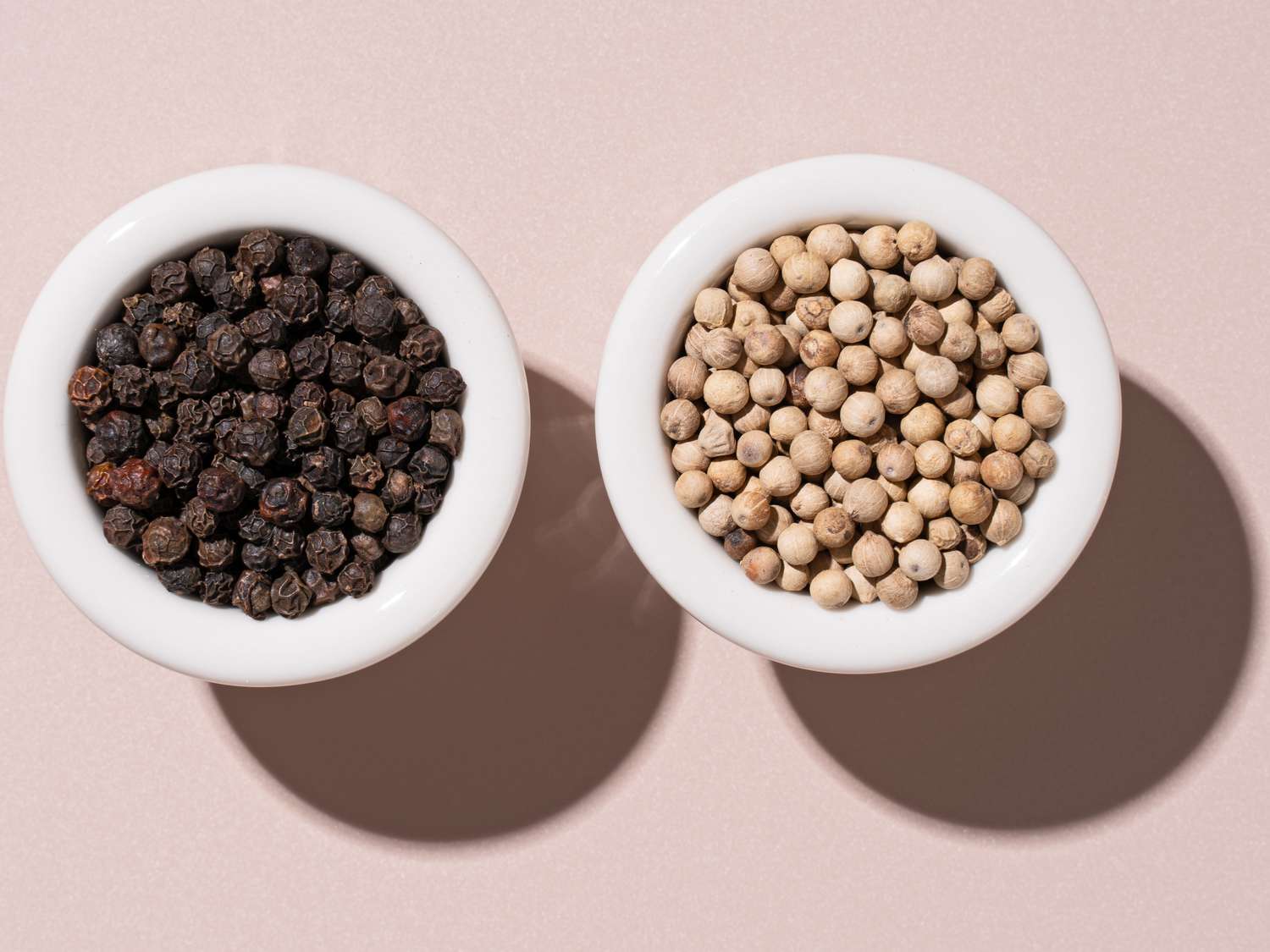
Have you ever ever seen a salt shaker with no pepper shaker beside it? The culinary duo is virtually inseparable—like peanut butter and jelly or macaroni and cheese. However whereas black pepper enjoys a primacy that places it on the heart of the eating desk, white pepper is often relegated to the again of the spice rack or pantry (in the event you even have it in any respect), even if the 2 are derived from the identical plant. Whereas black pepper is usually considered an on a regular basis seasoning, white pepper is extra of a specialist, lending its earthy taste to particular French, Chinese language, and Vietnamese dishes.
Black pepper is so ubiquitous that it may be straightforward to take without any consideration, however inside the world of black peppercorns—which really consists of white peppercorns, which we’ll contact on later—there are notable variations, and understanding them can elevate your seasoning sport by leaps and bounds. I chatted with Alex Wilkens, Vice President of Product at The Spice House, and Olivia Roszkowski, chef-instructor of plant-based culinary arts on the Institute of Culinary Education’s New York Metropolis campus, to study extra concerning the variations between black pepper and white pepper.
How Black Peppercorns and White Peppercorns Are Grown and Processed
“It is likely to be shocking, however black and white peppercorns each come from the identical berries on the pepper vine,” says Wilkens. The distinction between black peppercorns and white peppercorns is a matter of processing. Black peppercorns are the vine’s inexperienced fruits, picked when younger and greenish to orange in coloration. They’re harvested in clusters and dried within the solar or by machine till the outer shell, or pericarp, shrinks and turns into wrinkled and darkish brown.

Processing white peppercorns takes a further step—eradicating the pericarp to disclose the graceful cream-colored pearls of pepper inside earlier than drying. In response to The Washington Post, producers do that by soaking the peppercorns in water wherever from two days to 2 weeks, which softens the outer layer and contributes a further fermented taste and musky aroma.
What’s the Distinction Between Black Pepper and White Pepper?

Black peppercorns (Piper nigrum) are native to India and have been cultivated since 2,000 BC. They develop on vines that thrive in tropical climates, with lengthy tendrils of drupes (berry-like fruits with an interior seed) trailing down like verdant Nerd Ropes. The peppercorn itself is the interior seed, and the spice’s sharp taste comes from the antioxidant compound piperine, which is concentrated on this pit.
Making up a staggering 20% of the global spice trade, black pepper is without doubt one of the world’s hottest spices. There are many different varieties of black pepper, every with its personal flavorful profile—some with a brilliant pop of acidic warmth and others with a comfy backdrop of heat. Black peppercorns can current a wide range of characteristics relying on the variability, however usually, they are often, based on Wilkens, “fruity, earthy, piney, and sizzling.” White peppercorns, then again, have a uniquely musky taste profile and a extra aggressive warmth stage on account of the truth that peppercorn warmth is essentially concentrated within the white heart.
What Are the Greatest Makes use of for Black and White Pepper?
Floor black pepper is crucial for seasoning on a regular basis dishes in lots of cuisines. Wilkens factors to Tellicherry black peppercorns as a very good all-purpose pepper to load into your peppermill. “Grown in southwest India alongside the Malabar coast, Tellicherry pepper has remained the gold customary because the East-West spice commerce started centuries in the past,” says Wilkens. Black pepper can even present the spine in spice blends and dry rubs. Although it usually acts as a back-up singer, black pepper anchors dishes like cacio e pepe, pepper gravy, and steak au poivre.
White pepper has lengthy been favored in classical French recipes, together with foundational sauces like béchamel and soubise. “One of many benefits to utilizing white pepper in French cooking is that it disappears into white sauces, creamy soups, or whipped potatoes,” says Wilkens. It’s the presentation, reasonably than the particular taste, that’s necessary on this case, so you may actually make a beurre blanc with black pepper in the event you don’t thoughts seeing flecks in your butter sauce.
White pepper’s musky taste additionally pairs properly with warming spices like cinnamon, cloves, nutmeg, and ginger; the latter three elements are mixed with white pepper within the French spice mix quatre épices, which brings a wealthy fullness to savory purposes like pâtés, in addition to desserts like crepes and apple tarts.
Offered each complete and floor, white pepper can also be widespread in East Asian culinary traditions, particularly in Chinese language delicacies, the place it lends an fragrant contact to dishes like hot and sour soup and pork stir-fry. “White pepper can also be particularly widespread in Vietnamese delicacies, akin to in pho broths,” says Roszkowski, the place its earthy notes complement spices like star anise and ginger.
Can You Use Black and White Pepper Interchangeably?
There’s some disagreement round whether or not black and white pepper can be utilized interchangeably. Roszkowski says the 2 usually are not precisely interchangeable, however reasonably, higher suited to particular culinary purposes. Wilkens, then again, means that the 2 might be swapped, so long as you perceive what you’re working with: “Black pepper is a superbly acceptable substitute for white pepper in most recipes, ideally when it’s a really tremendous grind of black pepper, if that’s an choice,” says Wilkens.
Whereas Wilkens says black pepper has a milder warmth than white pepper, Severe Eats culinary editor Genevieve Yam really finds black pepper punchier, and calls white pepper extra delicate and delicate, so in some circumstances white pepper “could also be higher at highlighting the nuanced flavors of a dish,” she says. The 2 have completely different taste profiles, so which is extra pungent actually relies on who’s tasting it and even the particular peppercorns.
So, can you utilize white pepper as an alternative of black pepper and vice versa? “Undoubtedly,” says Yam. “So long as you settle for that what you are getting goes to be completely different! It is like toasted inexperienced tea vs. untoasted inexperienced tea—each scrumptious teas, however with their very own distinct flavors.” In the end, the most effective wager when swapping black pepper for white or vice versa (and actually any spice or seasoning substitution you make in cooking) is to begin on the lighter finish and style as you go, since you may add seasoning, however you may’t take it away.
The Takeaway
Whereas black and white pepper can typically be used interchangeably, white pepper is most well-liked in calmly coloured dishes the place seen flecks of black pepper could be undesirable. As a result of fermenting course of that it undergoes, white pepper has a delicate muskiness that may both complement or detract from a dish, which also needs to be thought-about when substituting one for the opposite. Inside the class of black pepper, there are numerous varieties that lend distinctive traits to dishes, so Wilkens urges cooks to discover completely different peppercorn blends. “You would possibly discover a new all-time favourite, otherwise you would possibly uncover you could’t reside with only one pepper in your spice pantry.”
Trending Merchandise











